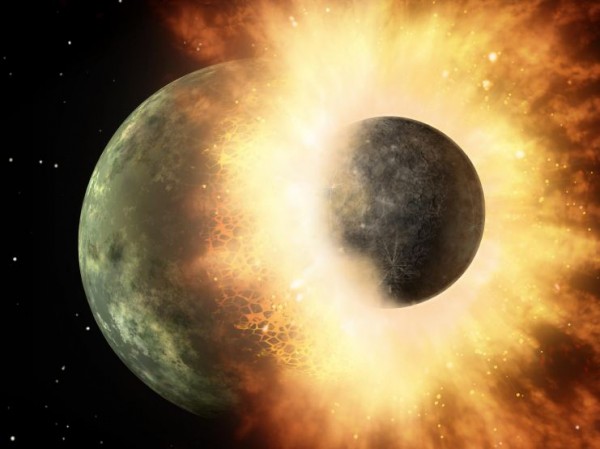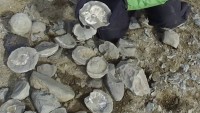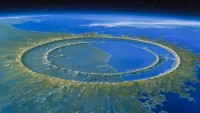Scientists Find 4.5 Billion Year-old Rocks Dating Back to Earth’s Infancy
| Arthur Dominic Villasanta | | May 16, 2016 04:15 AM EDT |
(Photo : NASA) Massive collisions formed the Earth
In a feat long considered improbable, scientists have discovered ancient rocks dating to almost the time the Earth was formed some 4.5 billion years ago by collisions with other celestial objects. A multinational team of scientists said these rocks are located in the mantle and date back to when the Earth was less than 50 million years old.
Like Us on Facebook
The team led by University of Maryland Professor of Geology Richard Walker discovered what they described as two "birthmarks" within Earth's mantle consisting of silicate material. The mantle is a layer between the crust and the outer core. It is a silicate rocky shell with an average thickness of 2,886 kilometers.
The team of researchers found clear signatures of this distinctive material in two widely separated locations: Baffin Bay in the North Atlantic and Ontong Java Plateau in the western Pacific Ocean. This is the first clear indication that portions of the mantle formed during Earth's primary accretion period still exist today.
"What we've found are surviving parts of Earth's primitive mantle that have been preserved for four and a half billion years, and I think that's kind of exciting," said Walker.
Scientists hold the Earth grew to its present size (a diameter 12,740 kilometers) through the accretion or accumulation of material from collisions with bodies of increasing size (such as asteroids) over several tens of millions of years in the early solar system.
The last and most massive of these impacts was a collision between the proto-Earth and a planetoid about the size of Mars (referred to as Theia) that resulted in the formation of the Moon. This giant-impact hypothesis is also called the Big Splash or the Theia Impact.
Scientific consensus believes it unlikely any vestiges of rock from the earliest-period of Earth's history have survived over the past 4.5 billion years. Scientists believe the physical mixing and internal heat caused by the many collisions with other solar system bodies would have homogenized all material from Earth's early mantle.
This theory, however, began to change with findings in 2012 by Walker and his colleagues that indicated some material from the primitive mantle continued to exist until at least 2.8 billion years ago.
"Four and a half billion years of geologic activity have overprinted much of the evidence for the processes involved in Earth's formation and initial chemical differentiation," said the paper reporting the discovery published in the May 13 issue of the journal Science.
The team's identification of primitive mantle material was based on detection of an overabundance of the radioactive element hafnium, an isotope of tungsten that decays into the tungsten. The isotope 182-hafnium is a form or isotope of the element that was present when that solar system formed, but is no longer present on Earth today.
Scientists said the decay of 182-hafnium into 182-tungsten is so rapid that variations in the abundance of 182-tungsten relative to other isotopes of tungsten can only be due to processes that occurred very early in the history of the solar system.
The team of researchers was from the University of Quebec at Montreal; the University of Maryland; the Carnegie Institution for Science; the University of California-Davis; McGill University and the University of California-Santa Barbara.
Corresponding author on the Science paper is Hanika Rizo, a professor of Earth and atmospheric sciences at the University of Quebec at Montreal.
This research was supported by NSF grant EAR-1265169 (Cooperative Studies of the Earth's Deep Interior program) to Professor Richard Walker of the University of Maryland and grant EAR-1250419 to Sujoy Mukhopadhyay of the University of California-Davis.
TagsEarth, University of Maryland, mantle, silicate, Theia
©2015 Chinatopix All rights reserved. Do not reproduce without permission
EDITOR'S PICKS
-

Did the Trump administration just announce plans for a trade war with ‘hostile’ China and Russia?
-

US Senate passes Taiwan travel bill slammed by China
-

As Yan Sihong’s family grieves, here are other Chinese students who went missing abroad. Some have never been found
-

Beijing blasts Western critics who ‘smear China’ with the term sharp power
-

China Envoy Seeks to Defuse Tensions With U.S. as a Trade War Brews
-

Singapore's Deputy PM Provides Bitcoin Vote of Confidence Amid China's Blanket Bans
-

China warns investors over risks in overseas virtual currency trading
-

Chinese government most trustworthy: survey
-

Kashima Antlers On Course For Back-To-Back Titles
MOST POPULAR
LATEST NEWS
Zhou Yongkang: China's Former Security Chief Sentenced to Life in Prison

China's former Chief of the Ministry of Public Security, Zhou Yongkang, has been given a life sentence after he was found guilty of abusing his office, bribery and deliberately ... Full Article
TRENDING STORY

China Pork Prices Expected to Stabilize As The Supplies Recover

Elephone P9000 Smartphone is now on Sale on Amazon India

There's a Big Chance Cliffhangers Won't Still Be Resolved When Grey's Anatomy Season 13 Returns

Supreme Court Ruled on Samsung vs Apple Dispute for Patent Infringement

Microsoft Surface Pro 5 Rumors and Release Date: What is the Latest?













